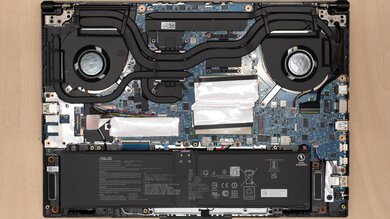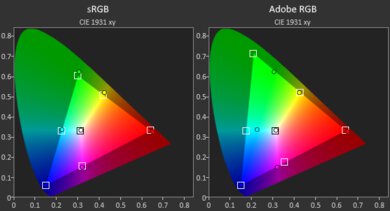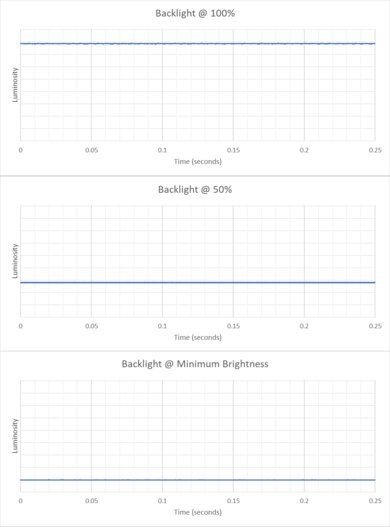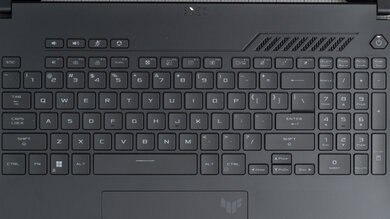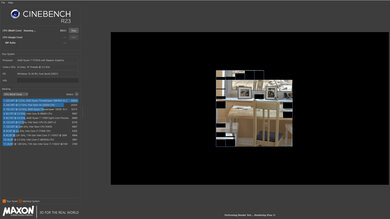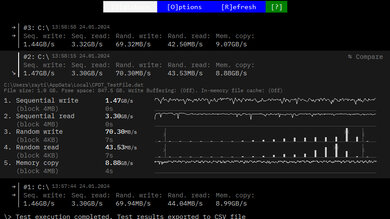The ASUS TUF Gaming A16 Advantage Edition (2023) is a gaming laptop with an all-AMD configuration. The 16-inch model is a new addition to ASUS' lineup, replacing the 15-inch ASUS TUF Gaming A15 from 2022. It's available with an AMD Ryzen 7 7735HS or Ryzen 9 7940HS CPU paired with an AMD Radeon RX 7600S or RX 7700S discrete GPU. Display options include a 165Hz FHD+ and a 240Hz QHD+ IPS display. It has a full-size keyboard with a Numpad, a 720p webcam, Wi-Fi 6 wireless connectivity, and a 90Wh battery.
See our unit's specifications and the available configuration options in the Differences Between Variants section.
Our Verdict
The ASUS TUF Gaming A16 is good for school use. Its AMD CPU and GPU can easily handle general productivity tasks and more demanding workloads, making it suitable for students in fields like 3D graphics and game development. It also provides a great user experience with its large display, comfortable keyboard, and responsive touchpad. Plus, its battery life is outstanding at nearly 13 hours of light use. The biggest downside is portability, as it's a rather bulky and heavy device.
- Sturdy build.
- Battery lasts around 13 hours of light use.
- CPU and discrete GPU can handle demanding workloads.
- Large screen for multitasking.
- Spacious keyboard, responsive touchpad.
- Bulky and heavy.
- Dim FHD+ display.
- Sub-par webcam.
The ASUS TUF Gaming A16 is an excellent gaming laptop. It's available with AMD CPUs and GPUs that can push high, consistent frame rates in demanding games at 1080p or 1440p, giving you smooth gameplay with minimal stutters. Display options include a 165Hz FHD+ and a 240Hz QHD+ panel; both support VRR to reduce screen tearing. It has a wide port selection for peripherals and external displays, and its RAM and storage are user-replaceable, so you can upgrade the system yourself later on. The keyboard provides clear tactile feedback but feels mushy when you bottom out. It also gets toasty under load, though it may not affect your gaming experience, as the hot spots are away from the WASD keys.
- Delivers smooth gameplay in intensive AAA games.
- No noticeable thermal throttling under load.
- High-refresh displays with VRR to reduce screen tearing.
- User-replaceable RAM and storage drive.
- Wide port selection includes USB4 and HDMI 2.1 support.
- Keyboard deck gets toasty under load.
The ASUS TUF Gaming A16 is decent for media consumption. Although it isn’t very portable, it has the advantage of having a large 90Wh battery, giving you over nine hours of video playback on a full charge. You can choose between a FHD+ or a QHD+ display; the latter is sharper, brighter, and more colorful, though neither is well-suited for dark room viewing due to their low contrast. Unfortunately, the speakers don’t get very loud and sound unnatural, with almost no bass.
- Large display.
- QHD+ display option with full DCI P3 coverage.
- Battery lasts over nine hours of video playback.
- Bulky and heavy.
- Dim FHD+ display.
- Quiet, basic-sounding speakers with almost no bass.
The ASUS TUF Gaming A16 is excellent for use as a workstation. While its AMD CPU and GPU aren’t the fastest you can find these days, they can handle fairly demanding tasks like video editing and 3D animation without many issues. You can get the laptop with a FHD+ or QHD+ display; the latter has full DCI P3 coverage, making it suitable for HDR video production. You get a comfortable full-size keyboard with a Numpad, as well as a wide port selection that includes USB4 support and a true HDMI 2.1 port. The RAM and storage are user-replaceable, so you can upgrade the system yourself later. Its performance over time is outstanding, though the keyboard deck gets toasty under load.
- CPU and discrete GPU can handle demanding workloads.
- No noticeable thermal throttling under load.
- User-replaceable RAM and storage drive.
- Wide port selection includes USB4 and HDMI 2.1 support.
- QHD+ display option with full DCI P3 coverage.
- Keyboard deck gets toasty under load.
The ASUS TUF Gaming A16 is good for business use. It's well-built, with a large screen for multitasking, a comfortable keyboard, and a responsive touchpad. Its AMD CPU and GPU can easily handle general productivity tasks like text processing, spreadsheets, and presentations, as well as more demanding tasks like photo and video editing, making it a great choice for small business owners needing to do a little bit of everything. Unfortunately, the webcam is sub-par, as the image looks noisy and overexposed, and portability isn't the best since it's a bulky 16-inch device.
- Sturdy build.
- Battery lasts around 13 hours of light use.
- Large screen for multitasking.
- Spacious keyboard, responsive touchpad.
- Bulky and heavy.
- Dim FHD+ display.
- Sub-par webcam.
Changelog
- Updated May 07, 2025: We've updated this review to Test Bench 0.8.3, which removes the viewing angle tests and adds a GPU Total Graphics Power comparison in the GPU section. The Pen Input test in the Extra Features section has also changed, as it now shows whether the laptop supports pen input rather than the inclusion of a stylus in the box. See the changelog for more details.
-
Updated Nov 01, 2024:
We've added mention of the Acer Nitro V 16 (2024) as an alternative with better keyboard temperatures under load in the Thermals and Noise section.
- Updated Mar 25, 2024: Added mention of the Dell Alienware m18 R2 (2024) as an alternative with NVIDIA GPUs in the GPU section.
- Updated Feb 14, 2024: Review published.
Check Price
Differences Between Sizes And Variants
We tested the ASUS TUF Gaming A16 Advantage Edition (model FA617NS-DS71-CA) with a 165Hz FHD+ display, an AMD Ryzen 7 7735HS CPU, an AMD Radeon RX 7600S discrete GPU, 16GB of RAM, and 1TB of storage. The display, CPU, GPU, memory, and storage are configurable; the available options are in the table below.
| Screen |
|
|---|---|
| CPU |
|
| GPU |
|
| Memory |
|
| Storage |
|
| Color |
|
See our unit's label here.
Popular Laptop Comparisons
The ASUS TUF Gaming A16 Advantage Edition 2023 is one of the best gaming laptops in its class. It stands out for its sturdy build, great gaming performance, and long battery life.
For more options, check out our recommendations for the best gaming laptops, the best budget and cheap gaming laptops, and the best workstation laptops.
The ASUS TUF Gaming A16 Advantage Edition (2023) is marginally better than the Lenovo LOQ 15 (2023) for most uses. The ASUS has a sturdier build, a better keyboard and touchpad, a faster SSD, and a longer battery life in light uses. It also has a higher-end 240Hz QHD display option with full DCI P3 coverage, making it suitable for color-critical work. However, the LOQ 15 has a better webcam and doesn't get as hot under load.
The HP Victus 16 (2024) and the ASUS TUF Gaming A16 Advantage Edition (2023) are both great budget gaming laptops with AMD CPUs. However, the HP uses NVIDIA discrete GPUs, while the ASUS uses AMD GPUs. Performance will depend on which configuration you get, though it's worth noting that NVIDIA's implementation of features like DLSS and Frame Generation typically perform better, at least in their current versions. On the other hand, the ASUS has an additional SSD slot, allowing you to store more games, and it'll provide a superior visual experience when gaming, as its displays support variable refresh rate.
The Acer Nitro V 16 (2024) and the ASUS TUF Gaming A16 Advantage Edition (2023) are both great 16-inch budget gaming laptops. These laptops offer a very similar user experience. The ASUS is better built and offers a higher refresh rate QHD+ display option than the Acer, but the Acer's display gets much brighter, and the laptop stays much cooler while gaming. The main differences come down to the hardware. While the ASUS features all AMD hardware, the Acer uses newer AMD 8040-series CPUs and NVIDIA GPUs. You can get similar levels of performance on either laptop, but NVIDIA's gaming features like DLSS, Frame Generation, and Reflex offer better visual fidelity and performance than AMD's FSR, Frame Generation, and Anti-Lag.
The MSI Katana A15 AI (2024) and the ASUS TUF Gaming A16 Advantage Edition (2023) are both excellent budget gaming laptops. The MSI is a better option if you're only looking for the best performance, as its Zen 4 AMD CPUs and NVIDIA 40-series GPUs are faster; however, the ASUS has a faster 240Hz display option, which will give you better responsiveness and smoother motion than the displays available on the MSI. In terms of the overall user experience, the ASUS is much better; it has a sturdier build, a larger touchpad, a wider port selection, and significantly longer battery life in light uses.
Test Results

The ASUS TUF A16 is available in a Black or Sandstorm (silver with a warm beige tone) color. See the bottom of the laptop here.
The hinge is outstanding. It feels smooth when opening and closing the laptop and is very stable. There’s only a tiny amount of screen wobble when typing aggressively. The hinge has a lot of resistance. You can still open the laptop with one hand; the resistance just makes fine adjustments more challenging.
The ASUS TUF A16 Advantage Edition's serviceability is great. Accessing the internals is straightforward; you only need to remove some Philips screws to take the bottom panel off. The screws are of different lengths, so it's best to keep them organized to make the reassembly easier.
See the service manual here.
The ASUS TUF A16 is available with the following displays:
- 16" IPS 1920 x 1200 165Hz
- 16" IPS 2560 x 1600 240Hz
The FHD+ display looks decently sharp on a 16-inch screen. You can see individual pixels up close, but that isn't an issue at typical viewing distances. Naturally, the QHD+ panel looks sharper with a pixel density of 190 PPI. Its increased sharpness makes it a better option for atmospheric and RPG games where you have time to fully appreciate the graphics or for productivity tasks. The 16:10 aspect ratio is becoming more common. It gives you slightly more vertical space than a 16:9 screen, which has little effect on gaming but helps with productivity because you can see more information at once when reading a document, reducing the need to scroll.
The ASUS TUF A16 is available with a 165Hz or 240Hz display. The 165Hz panel has a fast response time, resulting in a clear image with minimal ghosting in fast-moving scenes. Upgrading to the 240Hz display will provide better responsiveness; however, the difference isn't night and day and might not be immediately noticeable to some people. Both displays support variable refresh rate to reduce screen tearing.
The 165Hz FHD+ display doesn't get very bright. It's fine for indoor settings, but you may still have visibility issues if there's a lot of ambient lighting or if lights are directly shining on the screen. It gets very dim at the lowest brightness setting, though, which is great for dark room viewing as it causes less eye strain. The 240Hz QHD+ is much brighter, with an advertised brightness of 500 cd/m².
The display's reflection handling is good. Its matte coating works well in diffusing and reducing the intensity of bright light sources. Viewing light-color content isn't a problem; it's dark-color content that's hard to see, especially when there's a bright light shining directly on the screen.
The display's out-of-the-box accuracy is outstanding. The white balance and color inaccuracies are extremely minor and hard to spot with the naked eye. The gamma sticks to an almost flat 2.2, making dark scenes too dark and bright scenes too bright.
The 165Hz FHD+ display is an sRGB panel, meaning it only has full coverage of the sRGB color space. Its coverage of the wider Adobe RGB and DCI P3 is too low for print photography and HDR video production. The 240Hz QHD+ has full DCI P3 coverage.
The ASUS TUF A16 has a great keyboard. Its layout feels spacious and is relatively easy to get used to. The keys are stable, have a decent amount of travel, and require little force to actuate. They have a clear tactile bump to indicate the actuation but feel mushy when you bottom out. The backlighting is white, leaning on the cooler side. You can adjust the brightness and apply a lighting effect (static, breathing, strobing) using the F2, F3, and F4 hotkeys.
The touchpad is large and smooth. It tracks all movements and gestures well, though zooming in and out images doesn't always feel smooth. Palm rejection works with no issue. You can only click in the bottom half of the touchpad; the buttons feel mushy.
The ASUS TUF A16's speakers don't get very loud. They're best suited for spoken content, as they sound pretty basic and crude, with an unnatural timbre and no bass.
The webcam is sub-par. The image looks soft, noisy, and overexposed. Voices sound relatively clear but nasal, accompanied by some background static noise.
The ASUS TUF A16 Advantage Edition has a great port selection. The USB-A ports support USB 3.2 Gen 1 data transfer speed of up to 5Gbps. Both USB-Cs support USB 3.2 Gen 2 data transfer speed (up to 10Gbps) and DisplayPort; the only difference is that the one closest to the USB-A port supports Power Delivery, which lets you fast charge the laptop and other PD-compatible devices connected to the port. The HDMI is a true HDMI 2.1 port capable of outputting a 4k @ 120Hz signal.
The ASUS TUF Gaming A16's wireless adapter is a RealTek 8852BE. Some models have a MediaTek MT7921 adapter.
The ASUS TUF A16 is available with the following CPUs:
- AMD Ryzen 7 7735HS (8 cores/16 threads, up to 4.7GHz, 16MB L3 cache)
- AMD Ryzen 9 7940HS (8 cores/16 threads, up to 5.2GHz, 16MB L3 cache)
Both are technically high-performance CPUs but run at a lower wattage of 35W, so while they can handle fairly demanding workloads, they aren't as fast as the 45-watt H-series CPUs typically found in workstations and gaming laptops with more robust cooling systems. The Ryzen 9 7940HS is, on average, 15% faster than the Ryzen 7 7735HS and up to 30% faster in some workloads. The choice of the CPU depends on your usage and the games you play; the difference is minimal in GPU-limited games.
The ASUS TUF A16 is available with the following GPUs:
- AMD Radeon RX 7600S 8GB GDDR6 VRAM (95W TGP)
- AMD Radeon RX 7700S 8GB GDDR6 VRAM (120W TGP)
Both are mid-range GPUs designed for 1080p and 1440p gaming. Performance-wise, the RX 7600S is close to an NVIDIA GeForce RTX 3060 Laptop GPU, while the 7700S is closer to an RTX 3070 Laptop, performing up to 10% faster than the 7600S. There's a MUX (multiplexer) switch to allow the GPU to send information directly to the display without going through the integrated GPU, meaning you'll see dramatically better performance than on laptops that lack this feature. The performance difference can be anywhere from 10% to 25%, or more in some cases. To conserve battery, the system switches to the integrated GPUs during lighter workloads. The Ryzen 7735HS CPU has a Radeon 760M iGPU, while the 7940HS has a Radeon 780M. If you prefer a gaming laptop with NVIDIA GPUs, check out the Dell Alienware m18 R2 (2024)
You can configure this laptop with 16GB or 32GB of RAM. The memory is user-replaceable.
You can get this laptop with 512GB or 1TB of storage. The storage is user-replaceable; there are two M.2 2280 slots.
The AMD Ryzen 7 7735HS CPU’s performance is good but not great, which isn't surprising, as it's essentially a refresh of the older AMD Ryzen 7 6800H. It can handle general productivity tasks and some demanding workloads; just know that there are significantly faster processors on the market, like the AMD Ryzen 9 7845HX in the Dell Alienware m18 (2023) and Apple's M3 Max SoC in the Apple MacBook Pro 16 (M3, 2023). As for the GPU, the AMD Radeon RX 7600S’s score is great, with performance roughly equivalent to an NVIDIA GeForce RTX 3060 Laptop GPU, a lower mid-range graphics processor.
The AMD Ryzen 7 7735HS CPU performs well in Cinebench R23. Its multi-thread performance is where we expect it to be—better than the low-power U-series processors but not as fast as the more power-hungry H-series CPUs. It can handle demanding workloads, but again, there are significantly faster processors on the market.
The AMD Ryzen 7 7735HS CPU performs well in Blender; however, if you need to render images professionally, rendering with a discrete GPU is best. Even an entry-level discrete GPU like the NVIDIA GeForce GTX 1650 can render images faster. Unfortunately, Blender doesn't give the option to render with the AMD Radeon RX 7600S GPU in this laptop.
The AMD Radeon RX 7600S scores well in the Basemark GPU benchmark. Its performance is roughly equivalent to an NVIDIA GeForce RTX 3060; however, it can perform better in some games, particularly AMD-sponsored titles, bringing it closer to an RTX 3070 or 3070 Ti. This means it's mainly for 1080p gaming but can handle some titles at 1440p if you lower the graphical settings or use FSR (FidelityFX Super Resolution), a performance-boosting feature similar to NVIDIA's DLSS. The AMD Radeon RX 7700S is about 10% faster in most games.
We ran this benchmark in the Ultimate performance mode because the Standard mode automatically switches to the integrated GPU, resulting in a score of 23,857.
Models with an AMD Radeon RX 7700S GPU and a QHD+ display likely have a shorter battery life.
Borderlands 3 runs well on the ASUS TUF Gaming A16 with an AMD Ryzen 7 7735HS CPU and an AMD Radeon RX 7600S GPU. The gameplay is smooth, with only occasional stutters. You can even play this game at 1440p and still get over 60 fps with minimal tweaks in the settings.
The performance in Civilization VI is excellent. Regardless of the GPU configuration, frame rate isn't really a problem since this isn't a particularly GPU-intensive game. You can play this game at 1440p with no issue. Upgrading to the AMD Ryzen 9 7940HS won't noticeably improve the turn time.
Counter-Strike 2 runs very smoothly at 1080p with high settings. You can play this game at 1440p with no issue.
Shadow of the Tomb Raider runs well on the ASUS TUF Gaming A16 at 1080p. The gameplay is smooth, with almost no stutters, despite what the graph and results show. You can play this game at 1440p with no issue. The frametime spikes are scene changes and aren't representative of the performance.
The ASUS TUF A16's keyboard deck gets pretty hot under load. However, the hot spots are at the top and right side of the keyboard, so it's not too bad if you only use WASD and the surrounding keys when gaming. While loud, the fans aren't overly annoying or distracting. If you want a gaming laptop with better keyboard temperatures under load, consider the Acer Nitro V 16 (2024).
The ASUS A16 has a few pre-installed software applications, including:
- ASUS Armory Crate: Lets you monitor the system status and control the fan and power profiles.
- Dolby Access: Adds Dolby Atmos and Dolby Vision support. It also lets you change the sound and picture profile or create a custom sound profile through EQ.
- McAfee: Antivirus and anti-malware application. Requires subscription.
- MyASUS: Contains system and warranty information.
- Spotify: App for the music streaming service.





